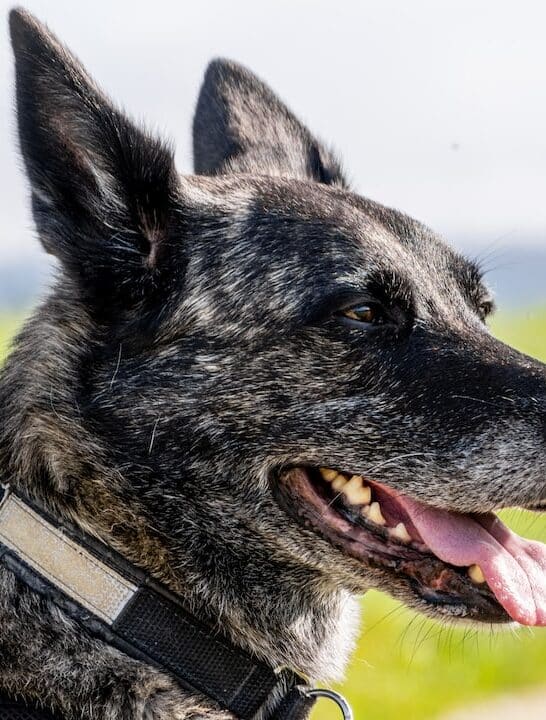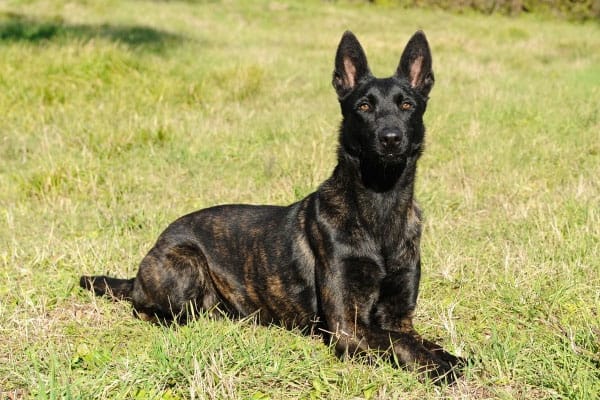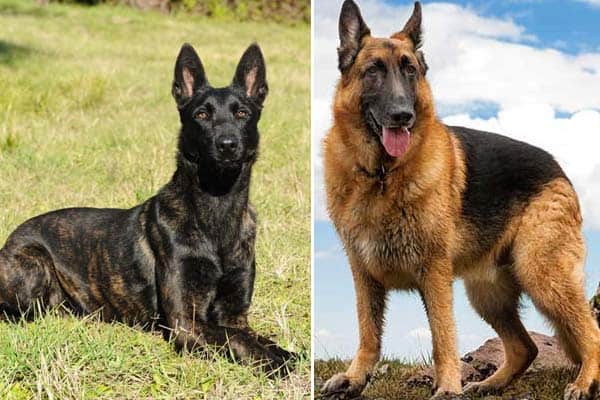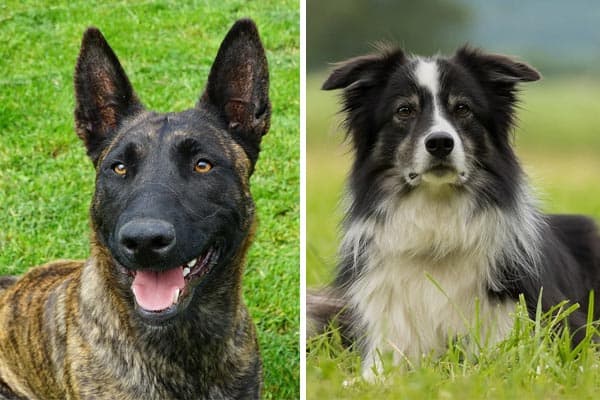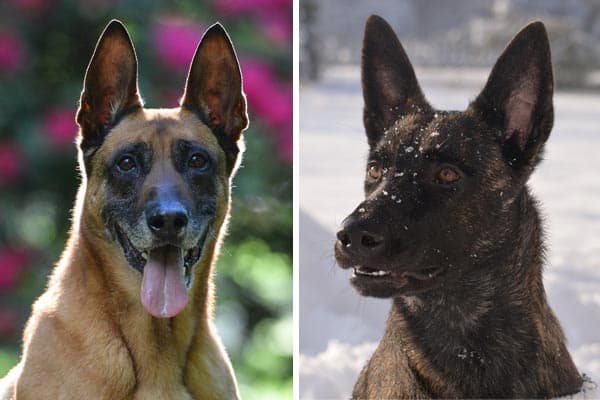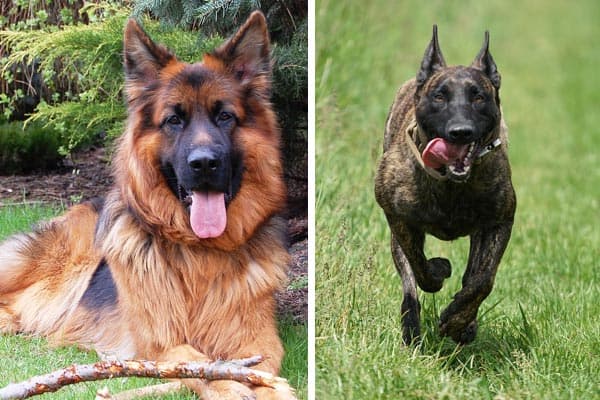The Extra-Rare Dutch Shepherd Husky Dog: What Should You Know About?
Most of us are at least somewhat familiar with the German Shepherd Husky mix. You have likely seen one, the curly-tailed fluffy black and white dogs with friendly and curious expressions.
The Gerberian Shepsky was probably around as an accidental mutt long before designer dogs became fashionable.
What about add adding a Dutch Shepherd to the Siberian Husky instead of the GSD? Does a rarer breed give you a more exotic-looking dog?
How could you describe a Dutch Shepherd Husky mix? A blend of a Siberian Husky and a Dutch Shepherd would produce a dog that requires a dedicated and active home. The combination is likely to be medium, strong, and brindle. Dutch Shepherd Huskies are energetic and intelligent. They get along with children and other dogs, but they need an occupation and thrive on adventure.
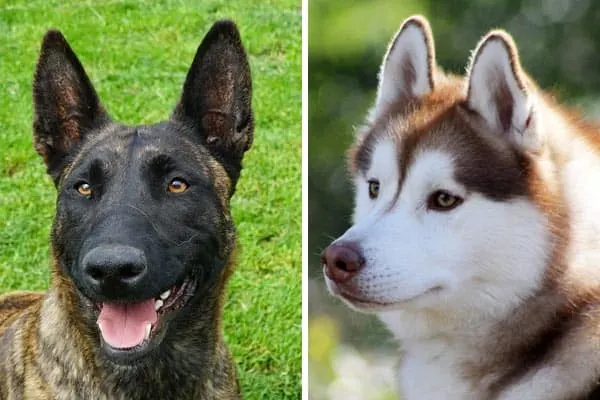
What is the history of the Dutchie Husky?
As the efforts persist in revitalizing the rare Dutch Shepherd and gaining full recognition by the AKC, it is doubtful many Husky mixes occur outside of an accidental pairing once in a blue moon.
It is also possible a curious breeder can produce an occasional Dutchie Siberian cross in keeping with the fascination with designer breeds.
The first Dutch Shepherd Siberian crosses probably originated in the United States after 2010.
The Dutch Shepherd is a herding dog from Brabant and other nearby areas in what is now the Netherlands. It was part of a large landrace group of generic herding dogs that eventually split from the German, and later the Belgian Shepherds, in the late 1800s.
A breed standard was proposed for the Dutch Shepherd in 1898, and a complete split from the Belgian Shepherds occurred around 1914.
Dutch Shepherds were versatile farm dogs who herded sheep in the meadows during the day as boundary herders, drove them independently to the stables at night to collect manure, guarded the grounds, tended children, and hauled carts of goods to market.
The United Kennel Club recognized the Dutch Shepherd in 1995.
Alternatively, the AKC accepted Dutch Shepherds as eligible for Foundation Stock Service certificates in 2012 and admitted them into the Miscellaneous Class in 2017.
The American Kennel Club has projected entry into the Herding Group and, thus, full AKC status, once the breed satisfies a few more criteria. UKC Dutchies do not automatically gain entry into the AKC.
Siberian Husky
According to Dogster.com and scientific sources, the Siberian Husky is one of the primitive breeds.
The Chukchi nomadic tribes developed the Siberian Husky around 985 BC in Siberia to pull sleds, either hauling whale-hunting equipment or caribou-herding gear and supplies. Siberian Huskies arrived in America in the early 1900s via Alaska and the fur traders.
The Siberian Husky became the 87th member of the AKC in 1930. Unlike the Dutch Shepherds, Siberian Huskies enjoy high popularity in the United States.
As of 2018, the Siberian was ranked No.14 of the most popular dog breeds, a status enhanced by such television hits like Game of Thrones and The Twilight Saga.
Crowning Achievement
If you ever find yourself looking at a Dutch Shepherd Siberian Husky cross, remember her forbears accomplished astounding feats as you attempt to confine and train her.
Founders of Koninklijke Nederlandse Politiehond Vereniging, or the KNPV, used Dutch Shepherds. Also known as the Royal Dutch Police, the group provides highly-sought premium working dogs to several places around the world who have a high demand for police, military, and sporting dogs.
Although some have heavy influences from Belgian Malinois crossings, KNPV Dutch Shepherds have an impeccable reputation as superior working dogs because of their trainability, nerves of steel, and high drive.
The only disadvantage is many KVPN Dutch Shepherds do not have papers, and a few dogs receive classification as one breed or another based on appearance.
In another part of the world, twenty teams of Siberian Huskies relay-sledded a life-saving antitoxin for diphtheria over 658 miles in blizzard conditions in less than six days. The incredible trek saved over 10,000 people in 1925 in Nome, Alaska.
A Disney feature, Togo, documented Togo’s role in leading his team over 260 miles under the direction of musher Leonhard Seppala. Seppala also bred Balto, a Siberian Husky who received many accolades for leading his team over the final leg of 50+ miles. Other teams covered an average of 30 miles each.
How involved will your grooming routine be?
Your Dutchie Husky mix will have a double coat with dense woolly underfur. It may seem counterintuitive, but your dog’s coat will keep her cool in the summer as well as warm in frigid weather. The hairs of the undercoat circulate air between the skin and outer fur, trapping cool air next to the skin.
A Dutch Shepherd Husky hybrid will likely have short or medium-long hair since shorter fur is usually dominant. You should brush him once to twice a week.
During the spring and fall, when he will shed much of his undercoat, you should increase your brushing to every day and bathe more frequently than usual. Brushing and bathing will help control shedding.
Groomers use a rake or pin brush for the undercoat and a bristle and slicker brush for the loose hairs on the outer coat. In the unlikely event that your dog inherits a wire-haired coat, then you may need to strip it every six months.
Dutch Shepherd
Dutch Shepherds have three coat types. The long-haired Dutch Shepherd is rare, and the wire-haired even scarcer. All varieties have a woolly undercoat.
- Short-haired – The outer coat is hard and lays flat.
- Long-haired
- Wire-haired – Curls in the wire-haired coat can hide any brindling. Dogs appear a muddy gray or salt and pepper. Removal of some outer hair or clipping will reveal the brindle coloration.
Siberian Husky
According to Pethelpful.com, Siberians Have three coat types, of which only one is acceptable for show dogs.
- Plush – Plush is the standard coat for a Siberian Husky. The outer coat is medium-long with dense soft underfur.
- Woolly – Still possessing a double coat, the woolly dog features long outer hairs that hide his conformation from view.
- Short – Like the woolly-coated dog, a Siberian Husky with a short coat cannot show in the AKC conformation events.
How much exercise will your hybrid need?
Your Dutch Shepherd Siberian Husky mix will require two hours of exercise every day. Activities should include a warm-up, strenuous cardiovascular exercise, training, ongoing socialization for dogs under two years old, and a cool down.
You can begin and end with walking, but your mix will require some high-intensity drills.
The great thing about your dog’s high energy level is you can use it as an opportunity to bond with your pet by engaging in activities you can perform together with, such as agility, Shutzhunde, Rally obedience, or search and rescue.
Rally obedience is growing in popularity as it is an event in which provisional AKC and mixed breeds can participate.
Handlers work with their dogs through a course with numbered signs that give directives. You perform the command with your dog, then move on. Rally can be a great introduction to other activities such as agility.
Dutch Shepherd
Dutch Shepherds need two hours of exercise every day that should include some form of mental stimulation. They get their high activity from their ancestors, who, similarly to the GSD, worked over several miles every day herding sheep or performing other work on the farm.
Siberian Husky
Siberian Huskies need two hours or more of daily exercise. Without mental stimulation included in their daily routine, Huskies will become anxious, bored, and destructive. They have as much stamina as the Dutch Shepherd, bred to cover miles every day hauling supplies across icy and snowy terrain.
Will Your Dutch Shepherd Husky Live Relatively Long?
If you are lucky enough ever to acquire a Husky Dutch Shepherd Cross, she will likely live 13 to 15 years. Both the Siberian Husky and Dutch Shepherd have an average lifespan of about 12 to 14 years.
Since Dutch Shepherd-Huskies are so rare, health problems they may have are largely speculative.
Hips
The good news is your hybrid is not likely to inherit hip dysplasia, one of the most common causes of pain, arthritis, and chronic debilitation in dogs. Per the Siberian Husky Club of America, Inc., Huskies rank No. 111 out of 114 breeds likely to have hip dysplasia based on radiographic evaluations from 1974 to 1994.
Compared to the Siberian Husky’s 2.2%, the Dutch Shepherd had an 8.3% occurrence of hip dysplasia in 2019, according to OFA statistics. However, this is extremely low relative to the German Shepherd at about 19% and the St. Bernard at a staggering 49%.
Eyes
Pannus (Dutch Shepherd) – An inflammatory condition of the cornea, Pannus causes a grayish film over the eye. With the potential to cause blindness, Pannus is more common in the GSD.
Progressive retinal atrophy (Husky) – A sex-linked problem in the Siberian Husky, PRA disrupts structures in the back of the eye and will cause affected dogs to go blind eventually. Usually, females with the gene are carriers and males with the gene develop PRA because of its presence on the X chromosome.
Glaucoma/Goniodysplasia – Linked to the wire-haired variety of Dutch Shepherd, Goniodysplasia will probably not appear in your dog.
Corneal dystrophy (Husky) – Ciid.discoveryspace.ca, which deals with canine inherited disorders, explains that Siberian Huskies inherit corneal dystrophy as an autosomal recessive trait. In other words, a puppy must inherit a copy of an abnormal gene from each parent to develop the disease.
Huskies acquire stromal dystrophy, which affects the thick middle layer of the cornea. The stroma is rich in collagen, and disease results in fatty deposits that appear as opaque areas. Most stromal dystrophies do not require treatment. Other breeds, including the GSD, can carry corneal dystrophy.
Autoimmune
- Hypothyroidism – The dog produces a low level of thyroid hormones as a result of an autoimmune attack on the thyroid gland.
- Atopy – Allergies, whether food or environmental, often manifest as itchy skin in dogs.
Obesity
Obesity is a growing problem in Siberian Huskies, who may live sedentary lifestyles or get too much to eat. Be mindful of feeding appropriate amounts at mealtime as both parent breeds adapted to keep their weights stable despite high exercise and relatively low food intake.
A good base amount of high-quality food for your hybrid is about 20 calories per pound of body weight daily split into two or three feedings. For premium foods, it works out to two measuring cups of kibble each day for a 60-pound dog.
Puppies over 12 weeks old eat 20 calories per pound of anticipated adult weight divided between three to four meals. You can adjust by 20% in either direction depending on if your dog is gaining or losing excess weight.
Will Dutch Shepherd Husky a Good Guard Dog?
Your hybrid should have a healthy wariness of strangers but will not react with shyness or charge them.
Dutch Shepherd Husky mixes will probably be friendly but perhaps not as outgoing as a Siberian Husky. His presence should deter intruders, and he may utilize other vocalizations besides barking. He will be an excellent watchdog and in some cases a good guard dog.
Dutch Shepherds
Dutch Shepherds are excellent guard dogs with great protective instincts. Well-socialized Dutch Shepherds respond readily to their owner’s cues and can discern appropriately between a friendly stranger and a threat. Most Dutch Shepherds do not attack or bite unless severely tested.
Siberian Huskies
Huskies usually make good watchdogs by vocalizing the arrival of visitors or the presence of something suspicious. Some are even slightly reserved with unfamiliar people, but most are extroverts. They can become protective if they sense danger.
How are they with children?
Dutch Shepherds and Siberian Huskies are playful and gentle with older children but require caution and supervision around toddlers and smaller kids. Dutchies can feel the need to herd small charges, and Siberian Huskies may topple small children in their rambunctiousness.
Expect your cross to have similar qualities to the parent breeds with a chance of inheriting some herding behaviors. You should socialize your Dutch Shepherd mix with all ages of children and people when she is under four months of age if possible.
Should you worry about other dogs?
Neither Siberian Huskies nor Dutch Shepherds are particularly dog aggressive. You probably see Huskies running free at dog parks regularly.
However, Siberians have a more-developed predatory instinct than Dutch Shepherds and can mistake tiny dogs as prey. You should always supervise your dog when a substantial difference in size between the two animals exists.
Your Dutch Shepherd Husky mix should be social and friendly with other dogs. You may notice a prominent prey drive or herding tendencies.
Your Dutch Shepherd Husky Should Do Well in a Dog-oriented Family
Dutch Shepherd Husky hybrids should take after their parent breeds and be loyal and affectionate with all members of the family unit.
The entire family must participate in training because the Dutch Shepherd, in particular, needs a special bond with her handler to perform commands effectively. Be aware your Husky mix may tend to want to run off.
How are training and intelligence?
Your Dutch Shepherd mix will be brilliant.
However, both the Siberian Husky and Dutch Shepherd historically worked independently, often with other dogs. They have developed to make many decisions for themselves.
Moreover, both breeds had to find ways to survive when food from their owners was scarce. Therefore, training can initially be challenging for Dutch Shepherds and Siberian Huskies.
Both the Dutchie and Husky and therefore your mix, require a firm and steady direction from a self-assured owner. The Dutch Shepherd Siberian Husky comes from an intense working dog heritage and may not be the best choice of pet for new owners.
Your Dutch Shepherd Husky Will be a Looker and Well-balanced
A Dutch Shepherd Siberian Husky mix is a medium-sized dog. Most will stand 19 to 24 inches tall at the shoulders and weigh from 45 to 72 pounds.
Your Dutchie Husky mix will have upright ears that, when the dog is on alert, will orient slightly forward of vertical. The head will be chiseled with a flat skull, a relatively long muzzle, and a wedge-shaped head.
Your dog’s eyes will be almond-shaped with a slight upward tilt at the outer corners. Eye color could be light to dark brown, blue, amber, or exhibit heterochromia, whereby the eyes are each a different color.
You may alternatively notice one or both of the eyes has multiple colors in the form of separate portions, marbling, or flecks.
A Dutch Shepherd mix has a strong and arched neck, long sloping shoulders, a compact build that is slightly longer than tall, a short loin (between ribs and hip socket), a relatively deep and broad chest, and powerful hindquarters. The back will be level and strong.
Dutch Shepherd mixes often have a plush tail, but some dogs with extremely short fur can have tails without any plumage at all. As an aside, an exceedingly short, sparse coat is a throwback of both breeds, and registries for either dog look on it as a serious fault.
Your Dutch Shepherd Husky mix will look exotic, especially if she inherits blue or amber eyes. She should give an impression of intensity, expectancy, alertness, and confidence.
Most Dutch Shepherd Siberian Husky mixes will be brindle, but they can have interesting patterns that you would not ordinarily see with a purebred Dutchie.
Other colors are possible, but most are recessive to brindle.
- Fawn
- Yellow
- Red and white
- Cream and white
- Black
Your dog’s gait should be efficient and ground-covering. The stride may be free, loose, and gliding like a Huskie’s or straightforward with no extraneous or flashy movements like the Dutchie. Some hybrids have a gait that incorporates the qualities of both parents.
Siberian Huskies are a wide array of colors.
- Red and white – Some dogs can be very pale red.
- Black and white
- Sable
- Wolf-grey
- Agouti – Hairs with a band of yellow; color agouti is the grayish and reddish-brown you see with animals in nature; Agouti is also the color associated with the “wild sable” gene in dog coat colors.
- Splash or pinto – Dogs have a large proportion of white in striking patterns resembling paint horses.
- Silver
- White
- Solid black
- Brown
- Black and tan
Dutch Shepherd
Similar to both the German Shepherd and Belgian Malinois, the Dutch Shepherd is about 21 to 25 inches tall at the shoulders and weighs 40 to 70 pounds. Dutchies are slightly longer than they are tall with a tail that has feathers in all coat varieties.
Dutch Shepherds are compact, strong, and balanced, with a flat skull, slight stop, dark almond-shaped eyes, and medium erect ears not as large as the Shepherd’s and not as triangular as the Husky. Their heads are wedge-shaped.
A Dutch Shepherd should have an efficient all-business gait, balance far outweighing any showmanship.
Dutch Shepherds are typically calm but intense. They are slightly reserved, a quality that may initially hide their liveliness and incredible drive. Dutchies should be neither overly shy nor aggressive.
Dutch Shepherds should always be brindle, although recessive dogs can be yellow or red.
Siberian Husky
Siberian Huskies are somewhat smaller than Dutch Shepherds, 20 to 23.5 inches tall, and 35 to 60 pounds. There is more of a size difference between the genders in Huskies than Dutchies. The AKC size standard is strict for Siberian Huskies.
Siberians are the tiniest bit longer than tall with level backs and powerful legs. Their gait, while efficient, shows obvious drive from the hindquarters and a reach in front that makes some of them seem to glide over the ground.
A Husky’s alertness, intensity, and intelligence are all evident in her expression and impression. Siberian Huskies should be friendly and outgoing.
Conclusion
There are not many Dutch Shepherd Siberian Husky mixes in existence. Seeing the two together can help you mentally combine them.
Do not let the apparent lethargy of these dogs fool you. Either the dogs already ran miles in the vast park, or it is a scorching day, albeit one of the Huskies is a little overweight. Notice the Dutch Shepherd is somewhat frantically searching for something to do.
The Dutch Shepherd displays the golden brindle short-haired coat. Even short-haired dogs have plumage on their tails. This Dutch Shepherd lacks the black facial mask that the breed standard prefers.
The far most Husky is silver and white, and the nearer Siberian laying down is black and white with one blue and one yellow eye.














